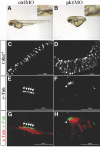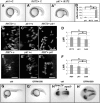Intraflagellar transport proteins are essential for cilia formation and for planar cell polarity
- PMID: 20576807
- PMCID: PMC2938599
- DOI: 10.1681/ASN.2009091001
Intraflagellar transport proteins are essential for cilia formation and for planar cell polarity
Abstract
The highly conserved intraflagellar transport (IFT) proteins are essential for cilia formation in multiple organisms, but surprisingly, cilia form in multiple zebrafish ift mutants. Here, we detected maternal deposition of ift gene products in zebrafish and found that ciliary assembly occurs only during early developmental stages, supporting the idea that maternal contribution of ift gene products masks the function of IFT proteins during initial development. In addition, the basal bodies in multiciliated cells of the pronephric duct in ift mutants were disorganized, with a pattern suggestive of defective planar cell polarity (PCP). Depletion of pk1, a core PCP component, similarly led to kidney cyst formation and basal body disorganization. Furthermore, we found that multiple ift genes genetically interact with pk1. Taken together, these data suggest that IFT proteins play a conserved role in cilia formation and planar cell polarity in zebrafish.
Figures




Comment in
-
More than maintenance? A role for IFT genes in planar cell polarity.J Am Soc Nephrol. 2010 Aug;21(8):1240-1. doi: 10.1681/ASN.2010060665. Epub 2010 Jul 22. J Am Soc Nephrol. 2010. PMID: 20651164 No abstract available.
References
-
- Huangfu D, Liu A, Rakeman AS, Murcia NS, Niswander L, Anderson KV: Hedgehog signalling in the mouse requires intraflagellar transport proteins. Nature 426: 83–87, 2003 - PubMed
-
- Kishimoto N, Cao Y, Park A, Sun Z: Cystic kidney gene seahorse regulates cilia-mediated processes and Wnt pathways. Dev Cell 14: 954–961, 2008 - PubMed
-
- Shillingford JM, Murcia NS, Larson CH, Low SH, Hedgepeth R, Brown N, Flask CA, Novick AC, Goldfarb DA, Kramer-Zucker A, Walz G, Piontek KB, Germino GG, Weimbs T: From the Cover: The mTOR pathway is regulated by polycystin-1, and its inhibition reverses renal cystogenesis in polycystic kidney disease. Proc Natl Acad Sci U S A 103: 5466–5471, 2006 - PMC - PubMed
Publication types
MeSH terms
Substances
Grants and funding
LinkOut - more resources
Full Text Sources
Molecular Biology Databases

